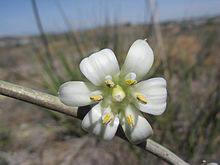Hesperaloe
| Hesperaloe | ||||||||||||
|---|---|---|---|---|---|---|---|---|---|---|---|---|

Blooming Hesperaloe funifera in Mexico |
||||||||||||
| Systematics | ||||||||||||
|
||||||||||||
| Scientific name | ||||||||||||
| Hesperaloe | ||||||||||||
| Engelm. ex S. Watson |


Hesperaloe is a plant genus in the family of the century plants (Agavaceae). The botanical name is derived from the Greek word "έσπέρα" (hespera) for evening or west and refers to the distribution area in North America and the similarity with the genus Aloe .
description
Vegetative characteristics
The species of the genus Hesperaloe are perennial , once flowering , succulent plants that form clumps with an onion-like, fibrous base. They grow with stemless rosettes that develop short to long rhizomes and have a thick and fleshy main root and numerous fiber roots. The few to numerous, linear-elongated, succulent leaves are fibrous . They are either thin, narrow, and arched to arched back, or thick, broad, and stiffly erect. The leaves are either close together or far apart and form large rings. The tip of the blade is designed as a hard thorn or is weathering.
Inflorescences and flowers
The inflorescence is up to 5 meters high and is racemose to panicley and consists of 3 to 8 partial inflorescences in the upper half. The stalked, six-fold flowers are narrow, bell-shaped with more or less inclined tepals . The inflorescence is tubular to narrow or wide bell-shaped to wheel-bell-shaped. The green, white and pinkish-brown to red, pink, salmon-colored or coral-red and only rarely yellow tepals have a fleshy keel, are about the same size, hardly overgrown and meet on the fleshy, nectar-forming flower axis . The stamens do not stick out. The anthers are dorsifix, arrow-shaped, open towards the center of the flower (intrors) and protrude or not. The Upper constant, triangular and dreifächrige ovary is ovate to oblong with numerous standing in two rows ovules . The stylus is elongated and extends only Hesperaloe parviflora subsp. bechtoldii out of the flower envelope. The scar is clearly head-shaped and lined with papillae .
Fruits and seeds
The stalked, persistent, cross-wrinkled fruits are septicidal, woody, round to egg-shaped capsules that are beaked or not. They contain large black, structured, up to 1 mm thick seeds .
genetics
The basic chromosome number is x = 30.
ecology
Either hummingbirds and bees ( Hesperaloe parviflora ) or bats and night owls ( Hesperaloe funifera , Hesperaloe nocturna ) act as pollinators . In Hesperaloe campanulata both Bestäubergruppen occur.
Systematics and distribution
The following internal system of the genre follows Fritz Hochstätter:
The genus Hesperaloe is distributed in the state of Texas in the United States and in northern Mexico in the states of Sonora , Coahuila , Nuevo León and San Luis Potosí . Two species are found in the west of the Sierra Madre Occidental and three species are mainly found in the east of the Chihuahua Desert .
It was first described in 1871 by Georg Engelmann . A distinction is made between the following types:
- Hesperaloe campanulata G.D. Starr
- Hesperaloe chiangii (GDStarr) BLTurner
- Hesperaloe engelmannii Krauskopf ex Baker
- Hesperaloe funifera (K. Koch) Trel.
- Hesperaloe malacophylla Hochstätter & Mart.-Aval.
- Hesperaloe nocturna gentry
-
Hesperaloe parviflora (Torr.) JMCoult.
- Hesperaloe parviflora subsp. parviflora
- Hesperaloe parviflora subsp. bechtoldii Hochstätter
- Hesperaloe tenuifolia G.D. Starr
The genus Hesperaloe is closely related to the genus Yucca section Hesperoyucca .
proof
literature
- J. Thiede: Hesperaloe . In: Urs Eggli (Hrsg.): Succulent lexicon. Monocotyledons . Eugen Ulmer, Stuttgart 2001, ISBN 3-8001-3662-7 , pp. 84-86 .
- Fritz Hochstätter : The genus Hesperaloe (Agavaceae) . In: CactusWorld . Volume 27, No. 2, 2009, pp. 97-106.
Individual evidence
- ^ In: S. Watson: Report of the geological exploration of the Fortieth Parallel. Volume 5: Botany. Appendix. Synopses of genera . P. 497, United States Government Printing Office , Washington 1871
- ^ Fritz Hochstätter, José Guadalupe Martínez-Ávalos: Una nuova specie di Hesperaloe (Agavaceae): Hesperaloe malacophylla Hochstätter & JG Martinez-Avalos spec. nov. In: Piante Grasse . Volume 30, No. 1, 2010, pp. 20-22.
further reading
- DJ Bogler, BB Simpson: A chloroplast DNA study of the Agavaceae . In: Systematic Botany . Volume 20, pp. 191-205, 1995; doi : 10.2307 / 2419449
- DJ Bogler, BB Simpson: Phylogeny of Agavaceae based on ITS rDNA sequence variation . In: American Journal of Botany . Volume 83, pp. 1225-1235, 1996; doi : 10.2307 / 2446206
- O. Pellmyr, EJ Augenstein: Pollination biology of Hesperaloe parviflora . In: Southwest Naturalist . Volume 42, pp. 182-187, 1997
- GD Starr: Hesperaloe: Aloes of the west . In: Desert Plants . Volume 11, No. 4, pp. 3-8, 1995
- GD Starr: A revision of the genus Hesperaloe (Agavaceae) . In: Madroño . Volume 44, pp. 282-296, 1997
- BL Turner, MW Turner: Natural populations of Hesperaloe (Agavaceae) in Texas . In: Lundilla . Volume 5, pp. 34-43, 2002
Web links
- Entry in the Flora of North America